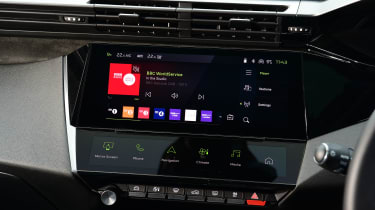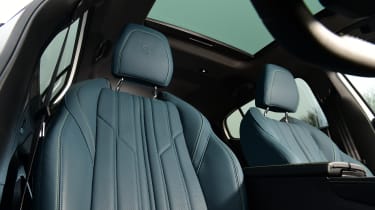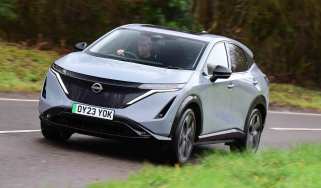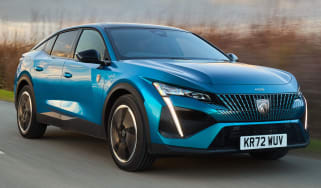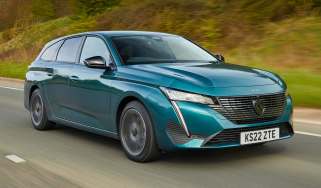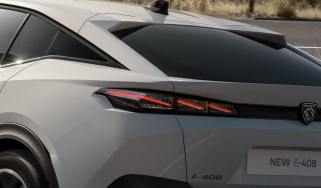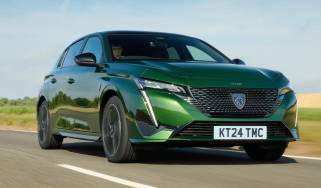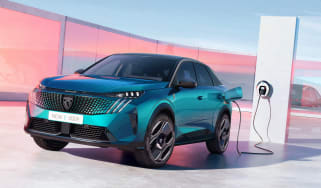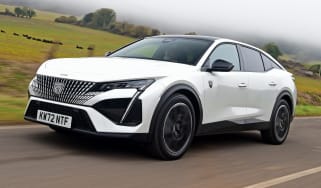Peugeot 408 review: a stylish and capable family car
The Peugeot 408 isn’t quite as sporty as its bold looks suggest, but it's a great all-rounder

The Peugeot 408 certainly has style, particularly in the cabin where the premium materials and crisp digital displays really help it stand out. This doesn’t come at the expense of substance, either. The 408 is a coupe SUV that gives very little away on practicality, thanks to a big boot and good rear passenger space, even compared to conventional mid-size SUV rivals.
The adventurous exterior design might divide opinion, as will the i-Cockpit setup, which invites drivers to peer at the instrument display over a small steering wheel. The 408 is a practical, comfortable car that doesn’t quite live up to the promise of the sporty design in the handling stakes. It also gets better as you ascend the trim level range and gain more of Peugeot’s desirable technology features.
Our choice: Peugeot 408 GT 1.2 Puretech petrol
About the Peugeot 408
The news that Peugeot was launching a new car called 408 may have caused people of a certain age to recall the Peugeot 405 and 406 family saloons from the 80’s, 90’s and early 2000’s that went up against famous names like Mondeo, Vectra and Passat in the D-segment’s golden age. The subsequent 407 of 2004 is probably better forgotten, partly due a face only its mother could love, and by that stage buyers were moving on. Today, traditional large family cars aren’t bought in anything like those numbers, prompting Peugeot to follow the money with the 408.
What we have here is what Peugeot calls a ‘C-segment fastback’. It combines elements of hatchback, SUV and four-door coupe to occupy a niche within the Peugeot range between the 308 hatchback, the 3008 SUV and the 508, which is Peugeot’s current take on the large family car genre.
Used - available now
The 408 is longer overall than the Peugeot 308 SW Estate and has a significantly longer wheelbase for more interior space, but there’s also a roofline that slopes away to the rear calling to mind large modern fastbacks like the electric Polestar 2 and Kia EV6. Elsewhere in the Stellantis group the Citroen C5 X offers much the same package.
Inevitably, buyers looking in this area of the market may also be considering more design-led mid-size SUVs like the Cupra Formentor, Mercedes GLA, BMW X2 or even the Range Rover Evoque. The 408 has the chunky bumpers and cladding along the sills and wheelarches familiar from the SUV class, establishing an obvious visual connection to those models.
So we have a car that’s tricky to pigeonhole but that offers a mix of qualities on paper that should appeal to a broad cross section of buyers. The availability of plug-in hybrid powertrains alongside the standard 129bhp 1.2-litre PureTech three-cylinder turbo petrol extends that appeal a bit further. The two plug-in options are badged Hybrid 180 (178bhp) and Hybrid 225 (222bhp) and like the entry-level petrol model they come equipped with a version of Peugeot’s eight-speed EAT (Efficient Automatic Transmission) gearbox.
Trim levels run from the entry-level Allure through Allure Premium to GT, but there’s also a limited run First Edition model, as is so often the case on new cars these days. Prices are in the £31,000 to £45,000 range and all models get Peugeot’s i-Cockpit and the i-Connect Advanced infotainment system that manifests itself on a 10-inch central touchscreen and a 10-inch digital instrument display. There’s connected navigation available with live traffic updates and over-the-air software updates but Apple CarPlay and Android Auto smartphone connectivity are also standard.
The entry-level Allure variants have 17” alloy wheels, LED headlights with Peugeot’s Smartbeam auto-dipping functionality, a reversing camera and ambient lighting for the cabin. The Allure Premium adds 19” wheels, ‘Open & Go keyless entry, adaptive cruise control and various other driver assist systems.
The GT models have design upgrades including large Peugeot lion badges on the front doors and 3D technology for the instrument display. The Driver Sport pack brings driving modes (Normal, Eco and Sport, plus Hybrid and Electric for the plug-in hybrid models) that alter the steering, throttle and gearbox settings.
The 408 is a car with a lot of technology features and a really special feeling cabin so we feel the plush GT trim is well worth splashing out on to get the full benefit. Probably in conjunction with the base petrol engine, rather than the hybrid options.
Engines, performance and drive
Peugeot clearly set out to give the 408 a sporty feel on the road to match the coupe-like looks but it has sensibly dialled-in decent levels of comfort as well. All models are front-wheel drive and feature Peugeot’s eight-speed EAT automatic gearbox.
The compact i-Cockpit steering wheel is still dividing opinion because its rim blocks the line of sight to the instruments for taller drivers. Your view of it (and those instruments) will depend very much on the specifics of your own dimensions and preferred driving position. At least there’s lots of scope for adjusting the position of the wheel and the driver’s seat so most people should be able to get comfortable.
The steering itself is light and devoid of the feedback that would hint at what the wheels are up to, but it’s quick enough and this combined with that downscale wheel give the 408 a nimble, pointy feel. If you feel like adjusting things, the drive mode selector gives access to basic Eco, Normal and Sport modes with the latter adding some urgency to the throttle response and extracting quicker shifts from the eight-speed automatic gearbox. There are Hybrid and Electric modes for the plug-in models, too.
How this Peugeot rides and handles on its MacPherson strut front suspension and twist beam axle rear set-up has a lot to do with your choice of powertrain. This is because the plug-in hybrid (PHEV) models are, predictably, quite a bit heavier – over 300kg to be precise.
On our tests we found the PureTech petrol model (1,392kg kerb weight compared to 1,696kg for the Hybrid 180) displayed good road holding and resisted body roll well enough through corners and quick direction changes. The ride was impressively smooth at cruising speeds but, on the 19-inch wheels, the suspension occasionally proved harsh and noisy on rough, potholed roads around town. Smaller wheels may well improve this.
Our drives in the plug-in hybrid models revealed more of a bouncy feel at slower speeds on those substandard urban roads and a little more body roll as the extra weight is transferred around in the bends. Overall though, the Peugeot 408 is a pleasant car to drive that can be fun when you’re feeling that way inclined and offers good levels of comfort and refinement.
0-62mph acceleration and top speed
The entry-level Puretech petrol is a three-cylinder engine with 129bhp and 230Nm of torque from 1,750rpm. It’s a small unit but performance is going to be adequate for a lot of buyers; 0-62mph takes 10.4 seconds, while the top speed stands at 130mph.
If you keep the revs down, it’s quiet but the EAT gearbox does have that tendency to drop a ratio or two when you ask for extra acceleration, sending the revs and the noise levels soaring without much of a pick-up in pace. The Puretech engine doesn’t sound bad at all but it’s much better to adopt a measured approach with your left foot and accept that progress is going to be dignified rather than brisk.
The Hybrid 180 and Hybrid 225 models are faster but the gearbox, dubbed e-EAT in this case, is still a bit of a weak link. It often switches between electric and petrol power less than seamlessly.
You also don’t gain a huge amount by switching up from the Hybrid 180 model with 178bhp to the Hybrid 225 with 222bhp. Both PHEV units have the same 266Nm maximum torque and there’s only 0.3s difference between the 0-62mph times (8.1 seconds for the Hybrid 180 and 7.8 seconds for the Hybrid 225) and both have a top speed of 140mph.
MPG, CO2 and running costs
As usual with plug-in hybrids, the Peugeot 408 PHEV models absolutely ace the official WLTP combined cycle fuel economy tests but getting 215mpg from the Hybrid 180 or 211mpg from the Hybrid 225 would require a borderline fanatical charging regime. At least the 24 to 30g/km CO2 emissions rating will help keep those company car tax bills in check.
The PureTech petrol gets between 41mpg and 48mpg on the official combined cycle tests with emissions of 133 to 156g/km, aided by the standard stop/start system and the 408’s slippery 0.28 drag coefficient.
Electric range, battery life and charge time
Both of the hybrid models combine a 1.6-litre petrol engine with a 12.4kWh lithium-ion battery and a 109bhp electric motor. They have an official electric-only range of around 40 miles but our tests have indicated something closer to 25 miles would be more realistic in the real world.
There’s a 3.7kW charger fitted as standard that will allow you to fully recharge the battery in 3 hours and 50 minutes from a standard 7.4kW home wallbox. Upgrade to the 7.4kW on board charger that’s available as an option and you can do the same job in an hour and 55 minutes.
Insurance groups
Insurance groups for the Peugeot 408 are between 19 and 21 for the 1.2-litre PureTech models, depending on the trim level. Go for the hybrids and they all slot into the 28 to 31 band. By way of comparison, the Cupra Formentor is pitched at a similar level for its entry-level petrol model but the plug-in hybrid versions are in groups 24 to 26 so should be a little cheaper to insure.
Check if your car needs an MoT and view its complete history with our MoT History Checker...
Depreciation
Residual value predictions for the Peugeot 408 are currently better for the PureTech petrol models than for the plug-in hybrids. You’re looking at one of those being worth around 49% of its list price after three years and 36k miles. With the hybrids, GT trim and the lower powered Hybrid 180 model perform the best, so you’re looking at 45% for that car, but around 42% for Hybrid 225 and 41% for the Allure models.
Generally, values are predicted to be lower than for the 308 hatchback, which is in the 46 to 48% ballpark. Our latest data suggests the Cupra Formentor will retain 57 to 59% of its value, which is slightly better than a Mercedes GLA (54 to 57%).
To get an accurate valuation on a specific model check out our free car valuation tool...
Interior, design and technology
Peugeot’s design department can give themselves a pat on the back for their recent efforts. Cars like the 208 and 508 have re-established the French brand’s reputation as a stylish option after a long period where Peugeots tended to look forgettable, or even gawky.
The 408 is adventurous even by recent Peugeot standards and not unsuccessfully so. We wouldn’t call it pretty but it’s certainly distinctive with those sharp, complex creases around the wings and down the flanks. Peugeot’s familiar nose with its fang-like daytime running lights are also present. If you don’t like the look of the plastic cladding around the sills and wheelarches, we’d recommend choosing a darker paint colour.
The Peugeot 408’s cabin is even more of an eye-opener than the exterior. Quality is great with lots of soft-touch plastics and there’s a real flair to the design. The Blue Naboo leather seats, available as part of the Driver and Passenger pack on GT models, looked and felt fantastic on our test car. Peugeot has merged the 408’s air-vents into one with an attractive row of slats that extend right actress the dash but there’s a lot of plastic below and that eats into the front passenger’s kneeroom.
All models have the small i-Cockpit steering wheel and configurable digital instrument cluster but the top spec GT cars get a 3D display that causes key elements of the display to stand out from the rest. It looks very flashy but doesn’t do a great deal for the clarity of the information in some of the screen modes, as key info like the car’s speed is quite small and it took us a while to pick it out. Admittedly this may improve the more you live with the setup and there’s lots of scope to choose your preferred layout.
Sat-nav, stereo and infotainment
At the centre of the cabin is the 10.25-inch Peugeot i-Connect Advanced touchscreen with a bank of configurable shortcut buttons below and a row of physical toggle stitches under that. The car comes with three years’ access to TomTom Live for traffic, speed camera and mapping updates on Allure trim and above.
The graphics are top-notch, with sharp edges and the widescreen display is very high resolution. Responses are fast enough, and route mapping is quick, although Peugeot persists with the need to scroll through menus when selecting functions, such as radio stations. The system scrolls very quickly, making it difficult to find the setting you want.
The ‘i-Toggle’ shortcut buttons can be altered to make your most used features quickly accessible but Peugeot has still provided a physical volume control knob, a move that should be commended. The screen and the buttons are set quite a way back, however, so taller drivers who have their seat set further away from the dash may need to lean forward to reach the controls.
All models get the usual DAB radio and there’s wireless Apple Carplay and Android Auto with the ability to connect up to two phones via Bluetooth. There are four USB charging points as standard as well.
On the top spec GT you can add a Focal premium HiFi system with 10 speakers. The other option boxes we would be sorely tempted to tick are the wireless charging mat and the Cielo panoramic sunroof.
Practicality, comfort and boot space
The Peugeot 408 certainly has a sleeker shape than the average SUV but when you get inside, it gives surprisingly little away in terms of practicality to more traditionally-proportioned rivals. Storage space inside is plentiful with carpeted door bins and a large glovebox ready to swallow your odds and ends.
There’s no rear windscreen wiper on the Peugeot 408 and although Peugeot has designed some clever aerodynamic bumps above the window that are supposed to help keep it clean, it did pick-up a fair bit of dirt on our winter test drives. Regular washing may be required.
Dimensions and size
The 408 is 4,687mm long, 2,062mm wide and 1,478mm tall. It’s a significantly bigger car than Peugeot’s 3008 mid-size SUV, which is only 4,447mm long, and it also measures up both longer and wider than rivals like the Cupra Formentor. The sleeker roofline does mean it is lower than the medium SUV class average, however.
Leg room, head room & passenger space
As you’d guess from the exterior dimensions, the space inside the Peugeot 408 is good, with the exception of headroom which you get less of than in more conventional SUVs. Access to the rear seats is easy enough through wide opening doors, though you do have to duck your head down a little. Once inside, it’s a little gloomy with the dark interior trim and tinted windows.
Boot space
The 536-litre boot is very impressive for the class. It’s 86 litres larger than the Cupra Formentor’s, and the low (665mm) load lip makes chucking heavier items in easier. By our own measurements, the space itself is 997mm long and 1,045mm wide so there’s a big square floor area, even if the car’s rakish rear window line does limit the height you can stack objects to.
There’s a small cargo hatch in the rear seat backs that you can poke larger items through. Alternatively, those seats split 60:40 and can be folded via levers in the boot area itself to reveal a 1,611-litre capacity. The seats don’t go completely flat so there’s a slope at the rear of the load area to contend with.
Towing
The Peugeot 408 has a 1,392kg kerb weight in 1.2-litre petrol form and can tow a 1,200kg braked trailer. The plug-in hybrids are both around 1,700kg in terms of kerb weight and can tow 1,400kg. You’ll find other mid-size SUVs with bigger towing capacities, including the Cupra Formentor, which can haul up to 1,800kg.
Reliability & safety
The Peugeot 408 has yet to face the series of immovable objects in the Euro NCAP crash test lab, but the closely-related Peugeot 308 hatchback has and It emerged with a four-star safety rating in 2022. The family hatch scored 78 per cent for adult occupant protection and 84 per cent for child occupant protection, plus a 65 per cent rating in the safety assist category.
The standard safety kit roster on all models includes Emergency Brake Assist, front, side and curtain airbags, lane-keeping assist, traffic sign recognition and driver attention alert. The hybrids also generate a sound to warn pedestrians at low speeds, where they’re otherwise very quiet. The Allure models get a more advanced radar and camera based emergency braking system while Allure Premium adds adaptive cruise control and rear cross-traffic alert. The GT has Lane Position Assist that will automatically keep the car centred in its lane.
Reliability is difficult to gauge with the 408 having only launched in 2022 and yet to appear in our Driver Power owner satisfaction survey. Peugeot has been doing very nicely in the manufacturer rankings though, with a 4th-place finish overall in Driver Power 2022. Peugeot owners like the way their cars look and drive in particular, and the brand as a whole ranked in the top 10 for reliability. Peugeot dealers were ranked 3rd overall so things are looking good for the brand.
Warranty
Peugeot offers a fairly standard warranty package on its cars of three-years and 60,000 miles. You’ll still get longer warranties on equivalent mid-size SUV models from Kia (seven years) and Hyundai (five years), while Toyota allows owners to extend their cover after each service.
Servicing
Peugeot offers a range of service plans for the 408, the plug-in hybrids being slightly more expensive to maintain than the PureTech petrol models. The standard service intervals are every 12,500 miles or 12 months for the petrol cars and every 18,750 miles or 12 months for the hybrids.
Peugeot 408 GT long-term test
The Peugeot 408 spent six months on our long-term fleet in the hands of group web editor Steve Walker. Although he wasn’t a fan of the rather firm ride and he suffered a few minor electrical gremlins, Steve was otherwise impressed by how the coupe-crossover performed as a daily family runabout.
The 408 certainly has a distinctive look and stands out from a crowd, while the slightly raised ride height helps with practicality, with the interior space and storage particular highlights. Steve was also impressed by the interior quality and thinks the materials used give it an upmarket feel. You can read the full long-term test here…
More reviews
Which Is Best
Most Economical
- Name1.6 Plug-in Hybrid 225 Allure 5dr e-DSC7
- Gearbox typeSemi-auto
- RRP£41,500





